Trains Kept A-Rolling: Southern California's Restaurant Bound Rail Cars

Years before the rise of the freeways, the Southland's framework was formed by the largest network of urban rail the world has ever known, the Pacific Electric Railway. It was only one of several railways that served the area, which was also criss-crossed by the Los Angeles Railway, the Atchison, Topeka, and Santa Fe Railway, the Southern Pacific, among others. Signs of Southern California's rail-heavy past are still in evidence in the depots, substations, and right-of-ways, which are still found throughout the region. The fate of the decommissioned rail cars varies, with most having been scrapped, but some repurposed and still around to visit today.
For decades, the main passenger rail services in Los Angeles were the Los Angeles Railway (LARy) and Pacific Electric (PE). LARy's last Yellow Car left the station in 1945. PE's last Red Car reached the end of the line in 1961. The routes of both were mostly replaced with buses or simply abandoned. In some PE cases, the routes were occasionally repurposed into bike trails, like the Bellflower Bike Trail, Metro Orange Line bicycle path, Pacific Electric Trail, and Whittier Greenway Trail.
The cars experienced a variety of fates, often doing time on Terminal Island (where they appeared in the 1951 film, "Hell Bound"), in Vernon Yard, or in the abandoned tunnels of the Hollywood-Glendale-Valley Subway before they were moved elsewhere. Some were shipped to cities like Buenos Aires, Busan, Cairo, Portland, Seoul, and Veracruz, where they continued to carry passengers until their retirement. In Chile, a company used old yellow cars to transport miners to and from work. Many went to museums, especially the Orange Empire Railway Museum in Perris, but also the Lomita Railroad Museum in Lomita, the Travel Town Museum in Griffith Park, the Los Angeles County Natural History Museum in Exposition Park, the Nethercutt Museum in Sylmar. One Red Car went to Seal Beach and itself became the museum.
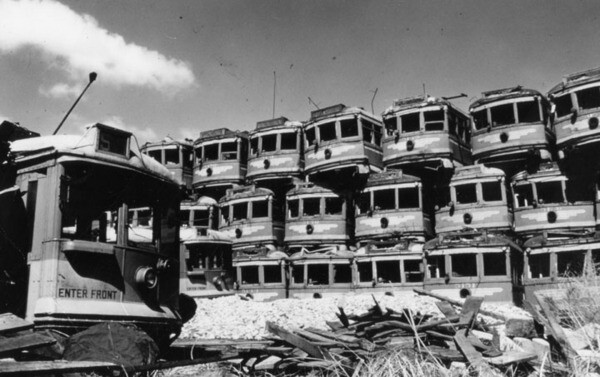
Most of the trains were scrapped, usually by Terminal Island's National Metal and Steel Corporation. Because the scrap value was mostly in the trucks and motors, most of the gutted husks were left intact. Many of those were ultimately used to create a couple of artificial reefs -- one off the coast of Redondo Beach and the other Huntington Beach, which is how the popular surf spot "Trolleycars" got its name.
Fewer, but a still significant number, found another fate, being converted into restaurants (as have many depots). The practice of turning old train cars into restaurants is probably almost as old as the train itself, and there are dining car restaurants around the world. Perhaps it's because dining on trains has an almost universally acknowledged romantic charm, especially compared to the miserable experience of "dining" on an airplane (which is probably why I've only been able to find one restaurant that attempts to recreate the experience of dining on one -- A380 in Chóngqìng). Dining on trains is generally such a pleasant experience that it has even inspired some restauranteurs to build replica train restaurants, like Phil's Diner (currently not in operation) in North Hollywood, and the best known, Pacific Dining Car in Westlake. In the 1970s train-themed dining became nationally popular, as evidenced by the then-expansive Victoria Station and the still popular Old Spaghetti Factory, the locations of which still are centered around replica train cars.
Southern California is still home to at least seven authentic dining car restaurants. A couple of the train cars are currently empty and some, like Mullen's Dining Cars, which once operated in Buellton, are no longer here (in Muellen's case a victim of a the automobile -- specifically the re-alignment of the 101). Here are those that I know of which remain.
Barstow Station McDonald's
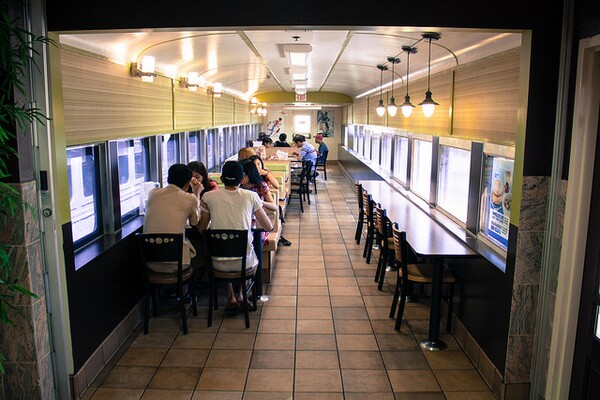
Three red-and-yellow-detailed (and golden arch-emblazoned) train cars are permanently parked at Barstow Station, maintained by an independent franchisee of the biggest global fast food chain. Barstow Station, whilst served by Greyhound and several shuttles and resembling a functioning train station, is more of a gift shop and fast food court than actual station. Harvey House Railroad Depot (fka Casa del Desierto), where Amtrak's Southwest Chief stops, is located not too far away. Barstow Station, on the other hand, is served by Barstow Area Transit's 1 and 2 bus lines.
Carney's

Radio advertising executive John M. Wolfe and his wife Pat opened the first Carney's on West Hollywood's Sunset Strip in 1975, utilizing two retired Union Pacific passenger train cars (Southern Pacific, Union Pacific's predecessor, first arrived in Los Angeles in 1877). A second Carney's opened on Ventura Boulevard in Studio City in 1981 and also occupies a train car. A third Glendale location, again located inside of a train car, didn't stand the test of time. The original Carney's is 3.5 km from the closest train station (Hollywood/Highland), but is served by Metro's 2/302 bus. The Studio City location is located even further from a functioning train station, (Universal City/Studio City Station) but is served by Metro's 150/240,167, and 750 as well as LA DOT's DASH Van Nuys/Studio City bus lines.
The DeLuxe Diner

A 1906 Pullman dining car (and later a "pie car" for the Hagenbeck-Wallace Circus) resides near the Five Points intersection of Ventura. It first opened as a restaurant in 1933, although at various times sense has served as an antique shop, a hobby shop, a motorcycle dealership, and most unlikely of all, a dance hall. The last tenant was the Sidecar Restaurant, which closed in 2013. Currently empty, it is nonetheless located very near Gold Coast Transit's Ventura Transfer Center.
Formosa Cafe
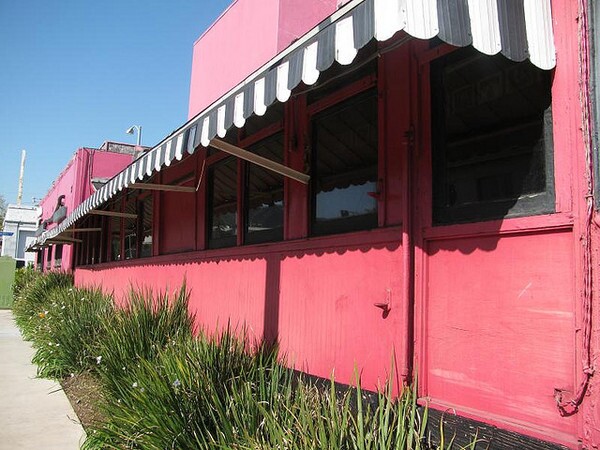
Prizefighter Jimmy Bernstein bought a 1902 Pacific Electric streetcar (No. 913) and began operating it as a restaurant in 1925. The famed West Hollywood eatery, located on Formosa (hence the name), was expanded to include more space -- or perhaps just to create more room to hang celebrity portraits. The closest train station to the Red Car-incorporating cafe is somewhat distant (Hollywood/Highland), but the restaurant is served by West Hollywood's free CityLine bus and Metro's 4 and 212/312 bus lines.
Red Wagon Cafe
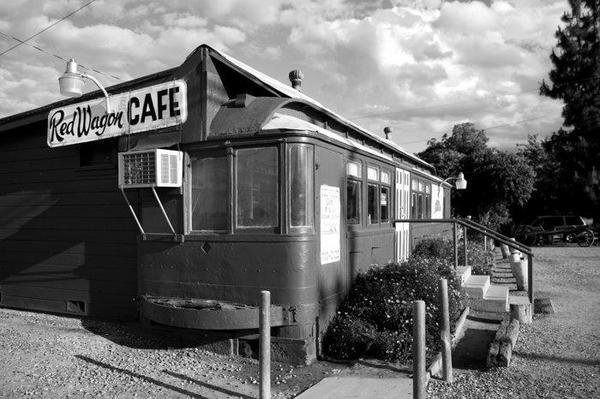
The Red Wagon Cafe in Shafter specializes in the exotic cuisine of Oklahoma. The train in question is an old Pacific Electric Car (No. 00197) that was turned into a restaurant in 1943. It opens every day (except Sundays) at 4:00 a.m. Though situated near freight rail tracks along the future route of California High-Speed Rail, the closest public transit currently gets is quite a ways away at Frontier High School in Bakersfield, courtesy of that city's Golden Empire Transit District 84 bus line.
Il Treno
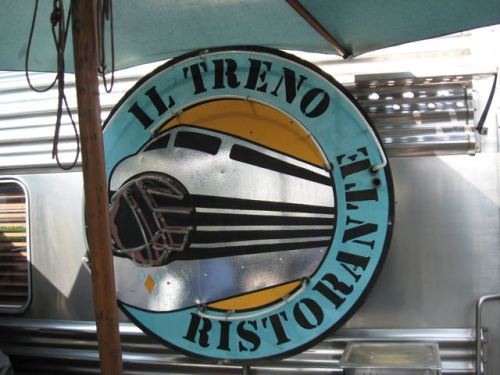
Il Treno was an Italian restaurant in Vernon operated by Peacock Cheese. The cheese company was established in 1946, but Il Treno operated between 1988 and 2010. The property is currently empty, although the train cars remain. Further away, the owners of Peacock Cheese operated a dining car restaurant in Paso Robles called Le Vigne.
Vintage Steakhouse
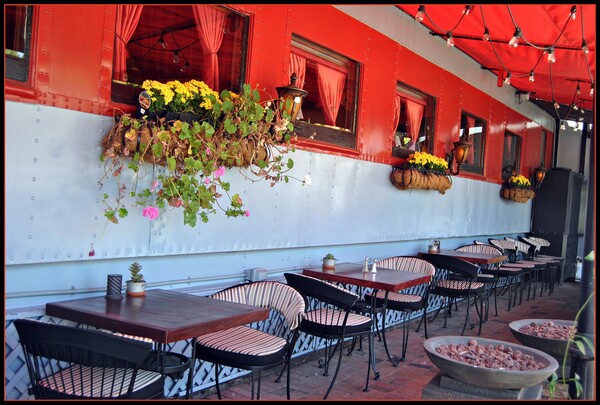
The Vintage Steakhouse is located in the San Juan Capistrano Depot which was built as station for the Atchison, Topeka, Santa Fe Railroad station in 1894, and located in San Juan Capistrano's Los Rios Street Historic District. The restaurant is located inside of a refurbished 1927 Pullman car, whereas the bar is in an adjacent freight house built in 1887. The San Juan Capistrano Depot is served by Amtrak's Pacific Surfliner and Metrolink's Inland Empire-Orange County Line and Orange County Lines.